Table of Contents
Top of page
Name
Summary
Distribution Map
Property List
Profile
Bibliography
Bottom of page
Fader 3
Fader ‘of Wilby’ (Norf.), fl. 1066
Male
CPL
4 of 5
Summary
Fader 3 was a substantial free man whose two manors in south Norfolk were assessed at 4 carucates and worth £4.Distribution map of property and lordships associated with this name in DB
List of property and lordships associated with this name in DB
Holder 1066
| Shire | Phil. ref. | Vill | DB Spelling | Holder 1066 | Lord 1066 | Tenant-in-Chief 1086 | 1086 Subtenant | Fiscal Value | 1066 Value | 1086 Value | Conf. | Show on Map |
|---|---|---|---|---|---|---|---|---|---|---|---|---|
| Norfolk | 19,11 | Wilby | Fader | Fader 'of Wilby', free man | - | William d'Écouis | - | 2.00 | 2.00 | 3.00 | E | Map |
| Norfolk | 19,11 | Wilby | - | Fader 'of Wilby', free man | - | William d'Écouis | - | 0.08 | 0.15 | 0.15 | E | Map |
| Norfolk | 19,13 | Banham | Fader | Fader 'of Wilby', free man | - | William d'Écouis | Odard 'of Banham' | 2.00 | 2.00 | 2.50 | E | Map |
| Norfolk | 19,13 | Banham | - | Fader 'of Wilby', free man | - | William d'Écouis | - | 0.25 | 1.10 | 1.10 | E | Map |
| Totals | ||||||||||||
Lord 1066
| Shire | Phil. ref. | Vill | DB Spelling | Holder 1066 | Lord 1066 | Tenant-in-Chief 1086 | 1086 Subtenant | Fiscal Value | 1066 Value | 1086 Value | Conf. | Show on Map |
|---|---|---|---|---|---|---|---|---|---|---|---|---|
| Norfolk | 19,11 | Wilby | - | 12 sokemen | Fader | William d'Écouis | - | 0.33 | 0.00 | 0.00 | E | Map |
| Norfolk | 19,13 | Banham | - | 16 sokemen | Fader | William d'Écouis | - | 0.20 | 0.00 | 0.00 | E | Map |
| Totals | ||||||||||||
Profile
The four occurrences of the name Fader in Norfolk can, on balance, be resolved into two individuals. They fall into two geographical pairs which passed after the Conquest to different Normans: two manors in north-west Norfolk to Ralph de Beaufour, two in south Norfolk to William d’Écouis. They were only 20-30 miles apart but the succession argues that we are concerned with two different TRE holders. An apparent overlap of tenure between the Normans (which might have involved manors first acquired by one being handed to the other) can be ruled out as illusory. A subtenant called Odar certainly held from both fiefs in 1086, in one place as a successor of Fader (Norf. 19:13, 27, 31, 40; 20:4, 9, 26, 28), and elsewhere in circumstances which seem to involve both Normans: one of Odar’s tenancies from William d’Écouis was at Thurlton, on the marshes of the lower Waveney in east Norfolk, where he held 45 acres which had belonged TRE to eight free men ‘over whom the antecessor of Ralph de Beaufour had only the commendation’ (de quibus antecessor Radulfi de bolla fago habuit commendationem tantum). In fact several others among the small free men who farmed at Thurlton TRE had also been commended to Ralph’s antecessor but did not pass under the lordship of William d’Écouis and Odar (Norf. 1:241; 4:57; 9:110; 19:40; 31:19; 50:13; 65:16).The most decisive factor in distinguishing Ralph de Beaufour’s predecessor Fader from William d’Écouis’s of the same name is the diplomatic of the relevant entries in LDB. At Great Bircham, Ralph’s Fader was specifically a ‘thegn of King Edward’ and simply ‘held’ his land (tenuit Fradre teinus regis E. .iii. carucatas terre). At Banham, William’s Fader in contrast was designated a ‘free man’ and ‘held . . . as a manor’ (tenuit Fader liber homo .ii. carucatas terre pro manerio). The different formulae have been shown to reflect LDB’s distinction between king’s thegns and free men (Roffe 2000: 27–30, 42). Even so, the other manor held by William’s predecessor has the simple ‘held’ formula (tenuit Fader) which in other circumstances denoted a king’s thegn rather than a free man. There is, of course, also the theoretical possibility of error in any of these formulae, omitting a phrase or including one by mistake. As a result, it is only marginally more likely than not that Fader 2 and Fader 3 were different people.
Fader 3’s manors of Wilby and Banham adjoined one another on the undulating plain of south Norfolk, the vills being divided by the extensive commons of Banham Moor. He had the largest share of the small vill of Wilby and one of the two largest holdings in Banham, a considerably larger vill where no pre-Conquest owner was dominant. His home farms at both places included two ploughs and livestock numbering 2 horses, 7 cattle, 17 pigs, and 70 sheep. There was abundant meadow (34 acres) and woodland (for 110 pigs). Besides the dependant peasantry (15 villans and 15 bordars with 2½ ploughs) and 5 slaves, Fader was lord of 28 sokemen who tilled 64 acres with 3½ ploughs. Both parish churches probably belonged to him: Wilby’s had only 10 acres of glebe worth 3s., but Banham’s had 30 acres worth 22s.
Bibliography
Roffe 2000: David Roffe, ‘Introduction’, Little Domesday Book: Norfolk, ed. Ann Williams and G. H. Martin (London: Alecto Historical Editions, 2001), 9–43
